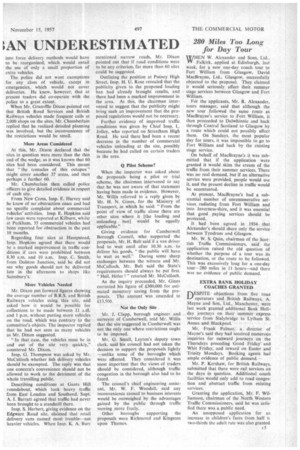IAN UNDERESTIMATED
Page 41

If you've noticed an error in this article please click here to report it so we can fix it.
into force delivery methods would have to be reorganized, which would entail the use of only a small proportion of extra vehicles.
The police did not want exemptions for any class of vehicle, except in emergencies, which would not cover deliveries. He knew, however, that at present traders did co-operate with the police to a great extent.
When Mr. Granvtlle Dixon pointed out that British Road Services and British Railways vehicles made frequent calls at 2,000 shops on the sites, Mr. Chamberlain replied that he realized detailed planning was involved, but the inconvenience of the restrictions would be small.
More Areas Considered
At this, Mr. Dixon declared that the sites in question were more than the thin end of the wedge, as it was known that 60 sites had been considered. This meant that "the tentacles of this octopus" might cover another 37 areas, and then perhaps a further 60.
Mr. Chamberlain then called police officers to give detailed evidence in respect of each site.
From New Cross, Insp. E. Harvey said he knew of no obstruction cases and had no specific complaint about commercial vehicles activities. Insp. E. Hopkins said few cases were reported at Kilburn, whilst at Peckham, 35 commercial vehicles had been reported for obstruction in the past 10 months.
Regarding four sites at Hampstead, Insp. Hopkins agreed that there would be a marked improvement in traffic conditions if cars were prohibited between 8_30 a.m. and 10 a.m. Insp. C. Smith, from Dalston Junction, said he did not see why goods should not be delivered late in the afternoon to shops like Sa insbu
More Vehicles Needed
Mr. Dixon put forward figures showing the average number of B.R.S. and British Railways vehicles using this site, and asked how it would be possible for collections to be made between 11 ilia. and 1 p.m. without putting more vehicles on the road, which was contrary to the committee's objects. The inspector replied that he had not seen as many vehicles as Mr. Dixon suggested.
"in that case, the vehicles must be in and out of the site very quickly," countered Mr. Dixon.
Insp. G. Thompson was asked by Mr. _McCulloch whether fish delivery vehicles should be exempted. The reply was that one concern's convenience should not be allowed to work to the detriment of the whole travelling public.
Describing conditions at Gar* Hill roundabout, which took heavy traffic from East London and Southend. Supt. A. I. Barratt agreed that traffic had never been brought to a standstill there.
Insp. S. Herbert, giving evidence on the Edgware Road site, claimed that retail delivery vans caused most trouble—not heavier vehicles. When Insp, K. A. Burr
mentioned narrow roads, Mr. Dixon pointed out that if road conditions were to be any criterion, far more than 60 sites could he suggested.
Outlining the position at Putney High Street, Insp. H. U. Rose revealed that the publicity given to the proposed loading ban had already brought results, and there had been a marked improvement in the area. At this, the chairman intervened to suggest that the publicity might bring such an improvement that the proposed regulations would not be necessary.
Further evidence of improved traffic conditions was given by Chief Insp. L. Jolley, who reported on Streatham High Road. He said there had been a recent decrease in the number of commercial vehicles unloading at the site, possibly because he had called on certain traders in the area.
Q Pilot Scheme?
When the inspector was asked about the proposals being a pilot or trial scheme, the chairman intervened to say that he was not aware of that statement having been made in evidence. However, Mr. Willis referred to a reply given by Mr. H. N. Ginns, for the Ministry of Transport, in which he said: "From the point of view of traffic alone there are other sites where it Ithe loading and unloading ban] would be equally applicable."
Giving evidence for Camberwell Borough Council, who supported the proposals, Mr. H. Butt said if a van driver had to wait until after 10.30 a.m. to deliver his goods, the public will have 'to wait as well." During some sharp exchanges between the witness and Mr. McCulloch, Mr. Bult said the State's requirements should always be put first. "Heil, Hitler I "retorted Mr. McCulloch.
As the inquiry proceeded. Mr. Ginns corrected his figure of 000,000 for estimated monetary saving from the proposals. The amount was amended to £13,500.
Not the Only Site Mr. J. Clapp, borough engineer and surveyor of Camberwell, told Mr. Willis that the site suggested in Camberwell was not the only one where restrictions ought to be imposed.
Mr. G. Small, Leyton's deputy town clerk, said his conned had not taken the decision to support the proposals lightly —unlike some of the boroughs which were affected. They considered it was most important that the views of traders should be considered, although traffic congestion in the borough also had to be faced.
The council's chief engineering assistant, Mr. W. F. Woodall, said any inconvenience caused to business interests would be outweighed by the advantages gained by the public through traffic moving more freely.
Other boroughs supporting the proposals were Richmond and Kingston upon Thames.








































































































